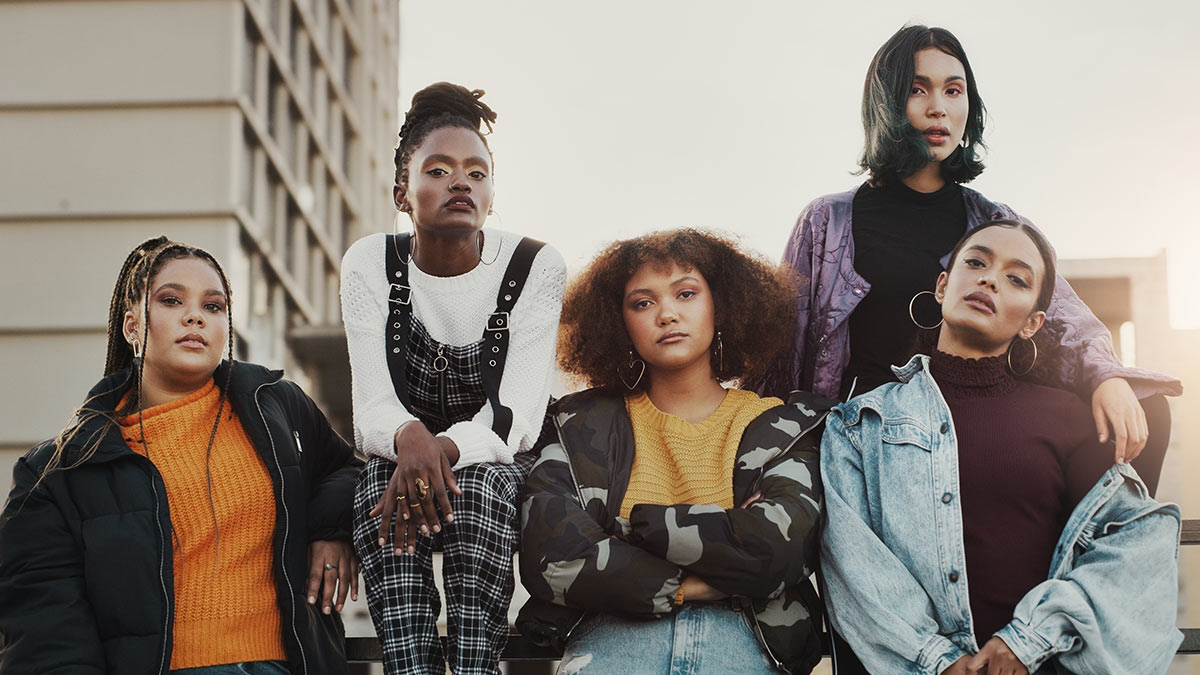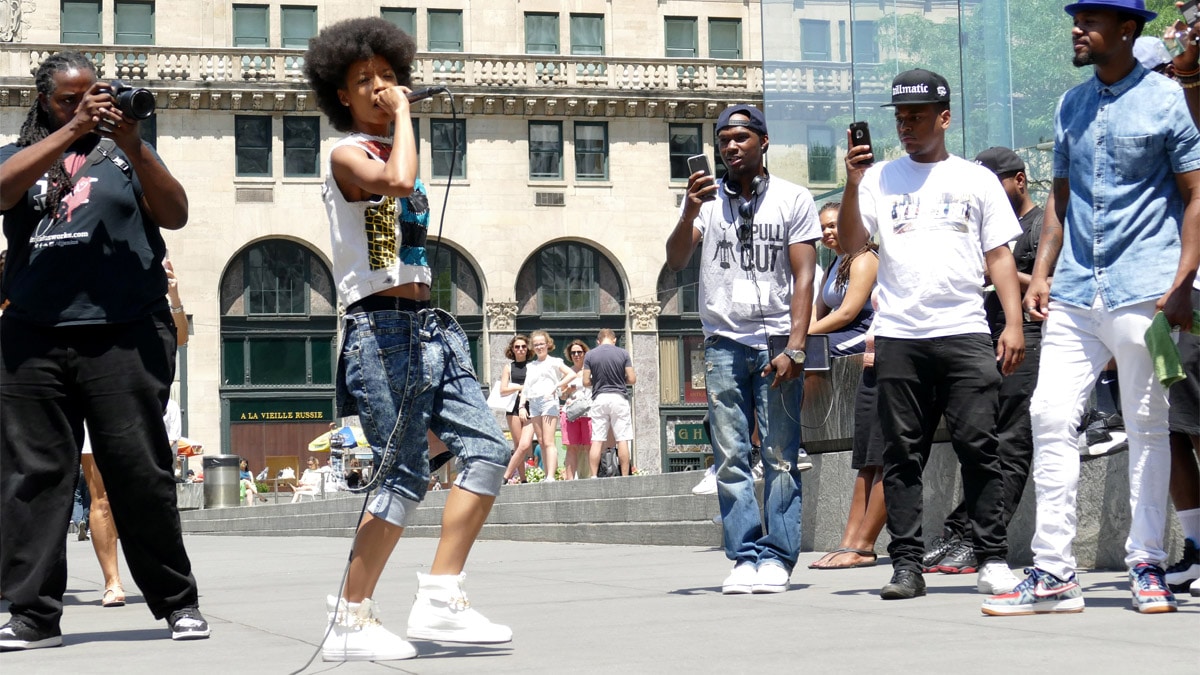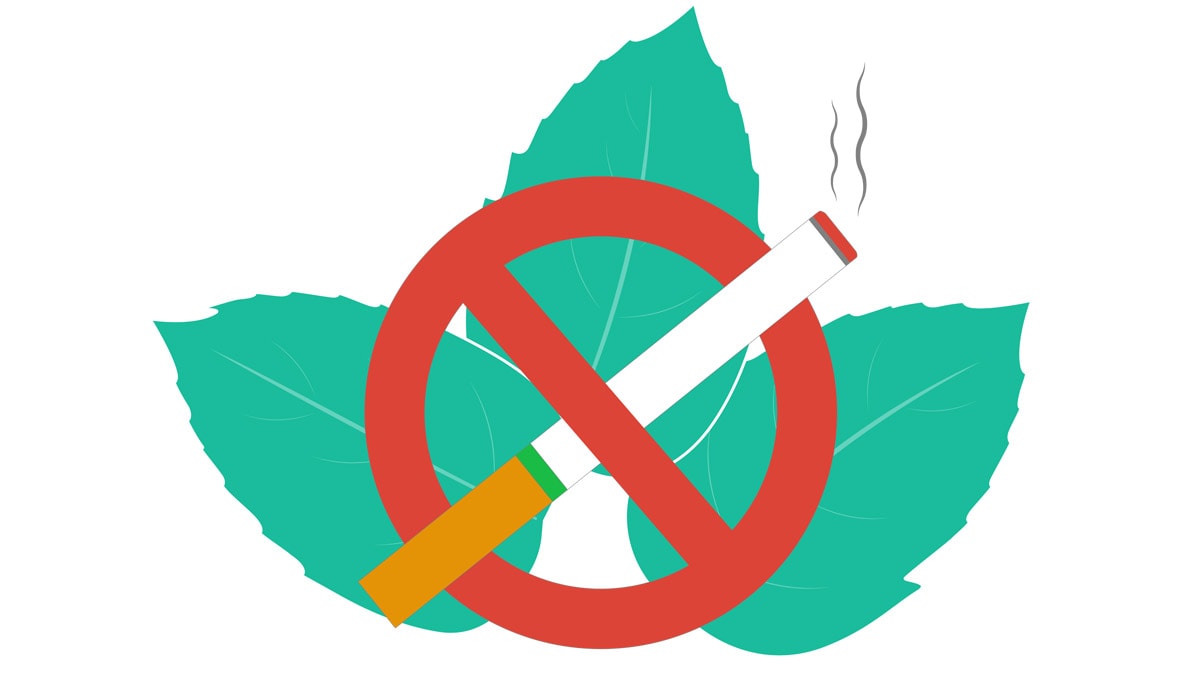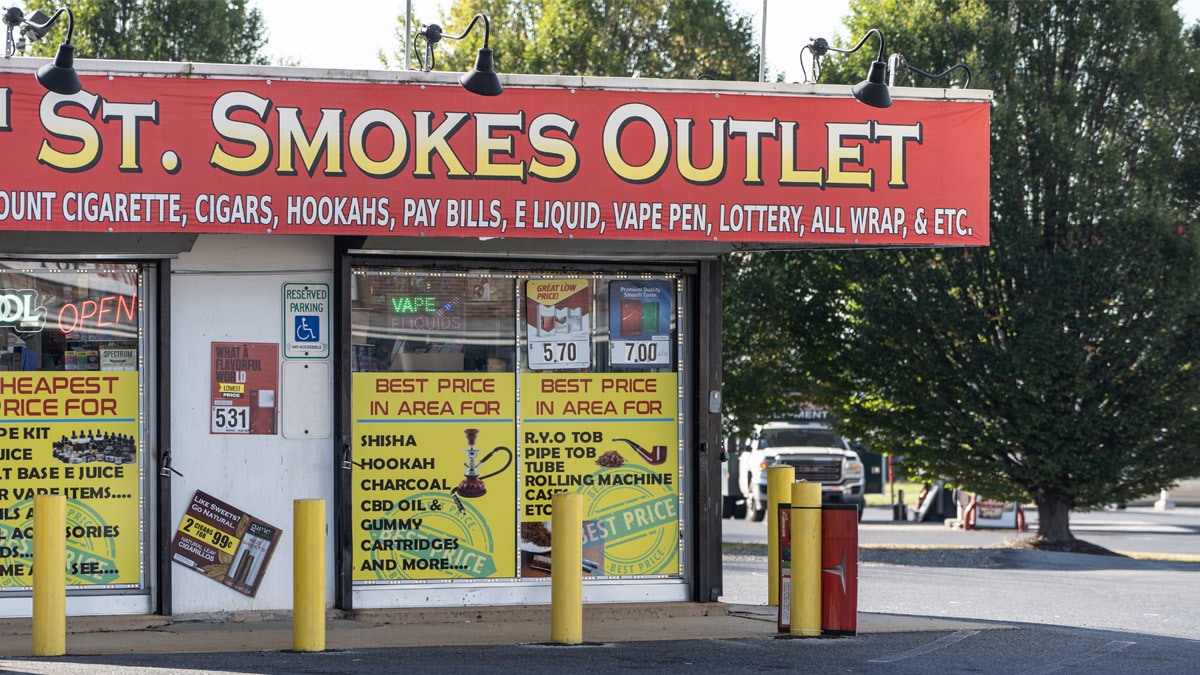At a glance
- The tobacco industry targets African American communities with marketing and advertising.
- Tobacco companies promote flavored products—especially menthol—in neighborhoods where African American people live.
- Stress can increase commercial tobacco use and make health problems worse.

Overview
Some U.S. historical policies and practices have led to mental and physical health risks and challenges, and related long-term health outcomes, for African American people. For example:
- For centuries, African American people have been harmed by unjust practices related to the sale of commercial tobacco.A123 For instance, enslaved people were forced to grow and harvest tobacco that would later be sold.2
- Tobacco companies have a long history of trying to influence African American people by donating to historically Black colleges and universities and sponsoring scholarships for African American students.41 They also give money to influential African American people, officials, and organizations.5 Tobacco companies have also advertised more heavily in magazines with larger numbers of African American readers.6
- African American people also experience discrimination and harm from systems meant to protect and improve health and well-being, including health care and medical science.789 Research shows that some African American people may hesitate to seek care because they don't trust the government or health care systems1011 that have treated African American people unfairly in the past.
- As recently as the 20th century, doctors and researchers have done studies and medical procedures on African American people without their permission or knowledge. During the Tuskegee Study of Untreated Syphilis in African American Men, researchers allowed Black men with syphilis to go untreated in order to compare their symptoms to Black men without syphilis who were also part of the study. Other times, African American women were sterilized (made unable to have children) without agreeing to it first. These actions led to mistrust of health care and medical research,121314 and help to explain some of the causes of health disparities.
Other reasons—like the ones explored below—help explain why the health of African American people is affected by commercial tobacco.
The tobacco industry targets African American communities with marketing and advertising
Marketing plays a big role in whether people try or use commercial tobacco products. Being around commercial tobacco ads makes smoking appear more appealing and increases the chance that someone will try smoking for the first time or start using commercial tobacco products regularly:1516
- Neighborhoods and areas with more African American residents tend to have more stores that sell tobacco.17
- Tobacco companies advertise more heavily in stores whose customers are mostly African American people.18
- Tobacco companies use price promotions such as discounts and multi-pack coupons—which are most often used by African American people and other minority groups, women, and young people—to increase sales.19
- Tobacco companies support cultural events designed to draw in certain groups in the Black community. One campaign targeted at Black young adults involved pop-up concerts featuring hip-hop artists in convenience stores.20

To help protect African American people from commercial tobacco marketing and discourage tobacco use, states and communities could consider increasing prices and prohibiting price discounts, prohibiting the sale of flavored tobacco products, and either allowing fewer stores in a neighborhood to sell commercial tobacco products or prohibiting tobacco product sales altogether.21
Tobacco companies promote flavored products—especially menthol—in neighborhoods where African American people live
Menthol has a minty flavor that can mask the harsh taste of tobacco. Menthol makes cigarette smoke feel easier to inhale and can make it harder to quit smoking.222324 To attract African American people as customers, tobacco companies target African American communities with advertising and sales of flavored cigarettes—especially those with menthol.1
Tobacco companies have aggressively marketed menthol cigarettes to African American people since at least the 1950s and continue to do so today.125
- In the 1970s and 1980s, a tobacco company's "menthol push" included ad campaigns with messages tailored to Black people and images featuring Black models or hip-hop icons.2627
- In 2019, about 85% of Non-Hispanic Black adults who smoked cigarettes used menthol cigarettes.28
- In 2019, about 58% of African American youth aged 12 to 17 who reported smoking cigarettes used menthol cigarettes.28
- Menthol products are given more shelf space in stores that have large numbers of Black customers.29
- Stores located near schools with more Black students have been more likely to promote menthol cigarettes through advertising and discounts.30 The more Black children who live in a neighborhood, the more likely it is that menthol specific marketing will be advertised near candy displays in stores.19
- Stores in neighborhoods with more Black residents or residents with lower incomes advertise flavored little cigars and cigarillos more often and may also have more of them available to buy.31

There are actions that states and communities can take to make flavored commercial tobacco products less available, which might help more African American people quit smoking (and might keep some African American people from starting to smoke).3233
- In 2009, the Family Smoking Prevention and Tobacco Control Act gave the Food and Drug Administration the authority to ban sales of all characterizing flavors in cigarettes, except menthol. Cities, towns, and communities that have limited the sale of flavored products have seen the odds of residents (including young people) using any type of tobacco products or trying flavored tobacco products go down.34
- A 2011 study that modeled what could happen if the U.S. banned sales of menthol cigarettes nationwide estimated that, by year 2050, such a policy could save more than 600,000 lives, including nearly 250,000 Black lives.35

Stress can increase commercial tobacco use and make health problems worse
Stress, such as that caused by financial problems, discrimination, or violence, can make people in general more likely to smoke.36
Racism and discrimination are constant sources of stress for many African American people.37 In 2019, the majority of African American people said they had personally been discriminated against because of their race. 38The pressure of discrimination has been associated with starting to use tobacco 3940and can also make it harder to quit.36
Health care itself can be a source of discrimination. One in three Black adults say they have personally experienced racial discrimination when going to the doctor—and many report avoiding seeking medical care because of it.41
When people experience severe or long-lasting forms of stress, their bodies respond by raising stress hormones and keeping them raised. When this goes on for a long time, they may develop health problems like high blood pressure and diabetes.4243 Smoking cigarettes also leads to disease and disability and harms nearly every organ of the body.44
- "Commercial tobacco" means harmful products that are made and sold by tobacco companies. It does not include "traditional tobacco" used by Indigenous groups for religious or ceremonial purposes.
- Gardiner PS. The African Americanization of menthol cigarette use in the United States. Nicotine Tob Res. 2004; 6(Suppl 1):S55–S65.
- Gately I. Tobacco: A Cultural History of How an Exotic Plant Seduced Civilization. Grove Press, 2001.
- Edmund S. Morgan, American Slavery, American Freedom: The Ordeal of Colonial Virginia. Norton; 1975.
- U.S. Dept of Health and Human Services. Tobacco Use Among U.S. Racial/Ethnic Minority Groups—African Americans, American Indians and Alaska Natives, Asian Americans and Pacific Islanders, and Hispanics: A Report of the Surgeon General. U.S. Dept of Health and Human Services, 1998. Accessed January 19, 2021. https://stacks.cdc.gov/view/cdc/13237
- Robinson RG, Barry M, Bloch M, et al. Report of the Tobacco Policy Research Group on marketing and promotions targeted at African Americans, Latinos, and women. Tob Control. 1992;1(Suppl 1):S24–S30.
- McCandless PM, Yerger VB, Malone RE. Quid pro quo: tobacco companies and the black press. Am J Public Health. 2012;102(4):739–750.
- Prather C, Fuller TR, Jeffries, IV WL, et al. Racism, African American women, and their sexual and reproductive health: a review of historical and contemporary evidence and implications for health equity. Health Equity. 2018;2(1):249– 259.
- Institute of Medicine. Unequal Treatment: Confronting Racial and Ethnic Disparities in Health Care. The National Academies Press, 2013. Accessed January 19, 2021. https://nap.nationalacademies.org/catalog/12875/unequal-treatment-confronting-racial-and-ethnic-disparities-in-health-care
- Institute of Medicine. Care Without Coverage: Too Little, Too Late. National Academies Press, 2002. Accessed January 19, 2021. https://nap.nationalacademies.org/catalog/10367/care-without-coverage-too-little-too-late
- Scharff DP, Mathews KJ, Jackson P, Hoffsuemmer J, Martin E, Edwards D. More than Tuskegee: understanding mistrust about research participation. J Health Care Poor Underserved. 2010;21(3):879–897.
- Armstrong K, Ravenell KL, McMurphy S, Putt M. Racial/ethnic differences in physician distrust in the United States. Am J Prev Med. 2007;97(7):1283–1289.
- U.S. National Institutes of Health, National Library of Medicine. 1976: Government admits forced sterilization of Indian Women. Native Voices, Native Peoples' Concepts of Health and Illness. Accessed January 19, 2021. https://www.nlm.nih.gov/nativevoices/timeline/543.html
- Stern AM. STERILIZED in the name of public health: race, immigration, and reproductive control in modern California. Am J Public Health. 2005;95(7):1128–1138.
- Novak NL, Lira N, O'Connor KE, Harlow SD, Kardia SLR, Stern AM. Disproportionate sterilization of Latinos under California's eugenic sterilization program, 1920– 1945. Am J Public Health. 2018;108(5):611–613.
- Carson NJ, Rodriguez D, Audrain-McGovern J. Investigation of mechanisms linking media exposure to smoking in high school students. Prev Med. 2005;41(2):511–520.
- Charlesworth A, Glantz S. Smoking in the movies increases adolescent smoking: a review. Pediatrics. 2005;116(6):1516– 1528.
- CounterTobacco.Org. Disparities in point-of-sale advertising and retailer density. Accessed January 19, 2021. https://countertobacco.org/resources-tools/evidence-summaries/disparities-in-point-of-sale-advertising-and-retailer-density/
- U.S. Federal Trade Commission. Federal Trade Commission Cigarette Report for 2017. U.S. Federal Trade Commission; 2019. Accessed January 19, 2021. https://www.ftc.gov/system/files/documents/reports/federal-trade-commission-cigarette-report-2017-federal-trade-commission-smokeless-tobacco-report/ftc_cigarette_report_2017.pdf
- Lee JG, Henriksen L, Rose SW, Moreland-Russell S, Ribisl KM. A systematic review of neighborhood disparities in point-of-sale tobacco marketing. Am J Public Health. 2015;105(9):e8– e18.
- National Center for Chronic Disease Prevention and Health Promotion, Office on Smoking and Health. Preventing Tobacco Use Among Youth and Young Adults: A Report of the Surgeon General. Centers for Disease Control and Prevention; 2012. Accessed January 19, 2021. https://www.ncbi.nlm.nih.gov/books/NBK99237/
- Ganz O, Rose SW, Cantrell J. Swisher Sweets 'Artist Project': using musical events to promote cigars. Tob Control. 2018;27:e93–e95.
- Robertson L, McGee R, Marsh L, Hoek J. A systematic review on the impact of point-of-sale tobacco promotion on smoking. Nicotine Tob Res. 2015;17(1):2–17.
- Ton HT, Smart AE, Aguilar BL, et al. Menthol enhances the desensitization of human alpha3beta4 nicotinic acetylcholine receptors. Mol Pharmacol. 2015;88(2):256–264.
- Oliver AJ, Jensen JA, Vogel RI, Anderson AJ, Hatsukami DK. Flavored and nonflavored smokeless tobacco products: Rate, pattern of use, and effects. Nicotine Tob Res. 2013;15(1):88–92.
- Brown & Williamson. The growth of menthols 330000-770000. Brown & Williamson Tobacco Corporation, 1978.
- Villanti AC, Mowery PD, Delnevo CD, Niaura RS, Abrams DB, Giovino GA. Changes in the prevalence and correlates of menthol cigarette use in the USA, 2004–2014. Tob Control. 2016;25(Supple 2):ii14–ii20.
- U.S. Food and Drug Administration. Preliminary Scientific Evaluation of the Possible Public Health Effects of Menthol Versus Nonmenthol Cigarettes. U.S. Food and Drug Administration. Accessed January 19, 2021. https://www.fda.gov/media/86497/download
- Substance Abuse and Mental Health Services Administration, Center for Behavioral Health Statistics and Quality. National Survey on Drug Use and Health, 2019. Substance Abuse and Mental Health Services Administration. Accessed January 19, 2021. https://datatools.samhsa.gov/nsduh/2019/nsduh-2019-ds0001/crosstab?column=NEWRACE2&control=CATAGE_RECODE&filter=CIG30MEN%21%3D91%2C93%2C94%2C97%2C98%26CATAGE_RECODE%3DRecoded_New_Category_adult&recodes=CATAGE_RECODE%7C1%3DRecoded_New_Category_youth%262%3DRecoded_New_Category_adult%263%3DRecoded_New_Category_adult%264%3DRecoded_New_Category_adult&results_received=true&row=CIG30MEN&run_chisq=false&weight=ANALWT_C
- National Cancer Institute. The Role of the Media in Promoting and Reducing Tobacco Use. U.S. Dept of Health and Human Services; 2008. Accessed January 19, 2021. https://cancercontrol.cancer.gov/brp/tcrb/monographs/monograph-19
- Center for Public Health Systems Science. Point-of-Sale Strategies: A Tobacco Control Guide. Center for Public Health Systems Science, George Warren Brown School of Social Work at Washington University in St. Louis and the Tobacco Control Legal Consortium; 2014. Accessed January 19, 2021. https://cpb-us-w2.wpmucdn.com/sites.wustl.edu/dist/e/1037/files/2004/11/CPHSS_TCLC_2014_PointofSaleStrategies1-2jps9wj.pdf
- Kong AY, Queen TL, Golden SD, Ribisl KM. Neighborhood disparities in the availability, advertising, promotion, and youth appeal of little cigars and cigarillos, United States, 2015. Nicotine Tob Res. 2020;22(12):2170–2177.
- Henriksen L, Schleicher NC, Dauphinee AL, Fortmann SP. Targeted advertising, promotion, and price for menthol cigarettes in California high school neighborhoods. Nicotine Tob Res. 2012;14(1):116–121.
- Giovino GA, Villanti AC, Mowery PD, et al. Differential trends in cigarette smoking in the USA: is menthol slowing progress? Tob Control. 2015;24(1):28–37.
- U.S. Dept of Health and Human Services. Smoking Cessation: A Report of the Surgeon General. U.S. Dept of Health and Human Services, 2020. Accessed January 19, 2021. https://www.hhs.gov/sites/default/files/2020-cessation-sgr-full-report.pdf
- Levy DT, Pearson JL, Villanti AC, et al. Modeling the future effects of a menthol ban on smoking prevalence and smoking-attributable deaths in the United States. Am J Public Health. 2011;101(7):1236–1240.
- Slopen N, Kontos EZ, Ryff CD, Ayanian JZ, Albert MA, Williams DR. Psychosocial stress and cigarette smoking persistence, cessation, and relapse over 9-10 years: a prospective study of middle-aged adults in the United States. Cancer Causes Control. 2013;24(10):1849–1863.
- Slopen N, Dutra LM, Williams DR, et al. Psychosocial stressors and cigarette smoking among African American adults in midlife. Nicotine Tob Res. 2012;14(10):1161–1169.
- Horowitz JM, Brown A, Cox K. Race in America 2019. Pew Research Center; 2019. Accessed January 19, 2021. https://www.pewsocialtrends.org/wp-content/uploads/sites/3/2019/04/Race-report_updated-4.29.19.pdf
- Robert Wood Johnson Foundation, Harvard T.H. Chan School of Public Health, National Public Radio. Discrimination in America: Experiences and Views. Accessed January 19, 2021. https://www.rwjf.org/en/insights/our-research/2017/10/discrimination-in-america--experiences-and-views.html
- Bennett GG, Yaus Wolin K, Robinson EL, Fowler S, Edwards C. Perceived racial/ethnic harassment and tobacco use among African American young adults. Am J Public Health. 2005;95(2):238–240.
- National Public Radio, Robert Wood Johnson Foundation, Harvard T.H. Chan School of Public Health. Discrimination in America: Experiences and Views of African Americans. National Public Radio; 2017. Accessed January 19, 2021. https://media.npr.org/assets/img/2017/10/23/discriminationpoll-african-americans.pdf
- Juster RP, McEwen BS, Lupien SJ. Allostatic load biomarkers of chronic stress and impact on health and cognition. Neurosci Biobeh Rev. 2010;35(1):2–16.
- Guyll M, Matthews KA, Bromberger JT. Discrimination and unfair treatment: relationship to cardiovascular reactivity among African American and European American women. Health Psychol. 2001;20(5):315–325.
- U.S. Dept of Health and Human Services. The Health Consequences of Smoking—50 Years of Progress: A Report of the Surgeon General. U.S. Dept of Health and Human Services, 2014. Accessed January 19, 2021. https://www.ncbi.nlm.nih.gov/books/NBK179276/
